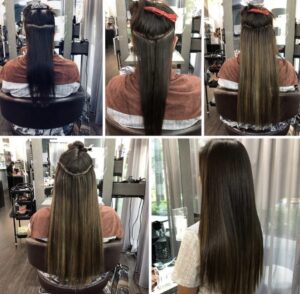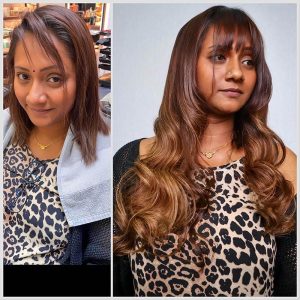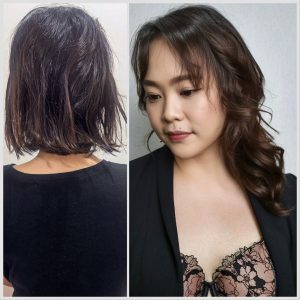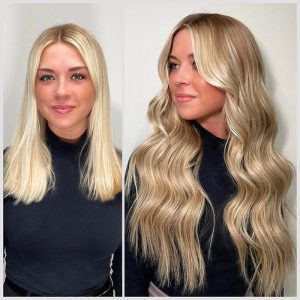Step into the intriguing world of hair extensions, a realm where every lock tells a story of sophistication, and the price tag holds untold secrets. Have you ever pondered why adorning your tresses with these luxurious strands commands a higher cost than many other hair services? It’s not merely a matter of added length or volume; there’s a tapestry of reasons, woven from the finest threads of skill, innovation, and dedication, that contributes to the premium value of hair extension services. In this journey, we will peel back the layers to reveal the meticulously crafted details and industry insights that justify the investment in your crowning glory. Let’s embark on a voyage of discovery, unraveling the hidden intricacies that make hair extensions a marvel of the beauty world.

Outline
- Technical Complexity and Customization
- Risk of Damage
- Maintenance Knowledge
- Investment in Quality Products
- Continuous Education
- Extended Service Time
- Health and Safety
- Customized Ordering and Inventory Management
- Correction and Removal
- Comprehensive Consultation Process
- Bulk Purchase Costs and Economic Considerations
- Market Differentiation and Quality Assurance
- Conclusion
1. Technical Complexity and Customization in Hair Extension Services
The process of applying hair extensions is far from a simple, one-size-fits-all service. It is an art form that demands a high degree of technical skill, an eye for detail, and an intimate understanding of hair dynamics. This complexity begins with the need for meticulous customization to ensure the extensions perfectly match the client’s natural hair in color, texture, and length.
The Art of Color Matching
Matching the color of hair extensions with the client’s natural hair is not merely about selecting a color from a sample book. Human hair exhibits a wide range of colors, often with multiple shades and highlights interwoven throughout a single head of hair. A skilled stylist must blend multiple shades and textures of extensions to achieve a look that is not just similar but indistinguishable from the client’s natural hair. This may involve custom-dying the extensions or using advanced techniques to layer different colors for a multidimensional effect.
Textural Integration
The texture of hair varies widely among individuals, from straight to wavy, curly, and kinky. Each type requires a specific kind of extension and application technique to ensure that the added hair moves, feels, and behaves like the natural hair. Achieving this level of integration requires an in-depth understanding of hair types and the proficiency to select and apply extensions that will blend seamlessly with the client’s own hair, preserving the natural flow and movement.
Custom Length and Volume
Clients seek hair extensions for various reasons, including adding length, volume, or both. The stylist must assess the client’s hair health and existing length to determine the appropriate length and volume of extensions. This is crucial to avoid placing undue stress on the natural hair, ensuring the extensions enhance rather than damage the client’s hair. Adding volume without length, for example, requires a different technique and choice of extensions than adding significant length.
The Demand for High Skill Level
The need for such high customization underscores the technical complexity of hair extension services. Stylists must undergo extensive training and continuously update their skills to master the latest techniques and products. They must have a keen eye for aesthetics to ensure the extensions not only match the client’s hair but also enhance their overall appearance. This level of expertise is what clients are investing in when they pay for hair extension services. It’s not merely about buying a set of hair extensions; it’s about purchasing a tailored, artistic service that transforms their appearance in a natural and flattering way. The technical complexity and need for customization in hair extension services justify the higher prices these services command. Clients are not just paying for the physical hair extensions but for the stylist’s expertise, time, and the personalized service that ensures the extensions look natural, feel comfortable, and maintain the health of their hair. This intricate process transforms hair extension services from a mere cosmetic procedure into a highly specialized art form.

2. Risk of Damage: The Importance of Expertise in Hair Extension Application
The application of hair extensions, while transformative, carries inherent risks if not executed with the utmost care and precision. Incorrectly applied extensions can lead to various forms of hair damage, such as breakage, thinning, and even alopecia (hair loss), primarily due to tension or the misuse of attachment methods. The responsibility on the shoulders of hair extension specialists is therefore substantial, as they navigate the fine balance between achieving the desired aesthetic outcome and maintaining the integrity of the client’s natural hair.
Understanding Scalp Health and Hair Strength
A specialist’s first line of defense against the risk of damage is a thorough understanding of scalp health and the structural strength of the client’s hair. This knowledge is crucial for several reasons:
- Tension Awareness: Different methods of hair extension application exert varying degrees of tension on the natural hair and scalp. Techniques that pull too tightly or place undue stress on hair follicles can lead to traction alopecia, a condition where hair is pulled out of the scalp, leading to noticeable thinning and bald spots.
- Method Suitability: Not all hair extension methods are suitable for every hair type. For instance, tape-in extensions may be less damaging for thin, fine hair compared to heavier, sewn-in wefts that could pull and strain weak roots. Selecting the right method based on the client’s hair type is essential to minimize the risk of damage.
- Chemical and Heat Damage: Certain attachment methods involve chemicals or heat, which can weaken hair shafts and lead to breakage if not applied carefully. A specialist must possess the skill to use these methods without compromising the health of the hair.
The Role of Customized Consultation
The consultation process is a critical step where the specialist assesses the health and suitability of the client’s hair for extensions. This is when the stylist evaluates:
- The density and texture of the natural hair.
- Any existing damage or weaknesses.
- The client’s hair care routine and lifestyle, which can influence the choice of extension method and maintenance plan.
Continuous Education and Training
Given the evolving nature of hair extension technologies and techniques, specialists invest in continuous education and training to stay abreast of the safest, most effective application methods. This commitment to professional development is not only a pursuit of excellence but also a preventative measure against causing harm to clients. The extensive training, experience, and nuanced understanding of hair health required to safely apply hair extensions contribute significantly to the cost of these services. Specialists are not merely performing a cosmetic service; they are applying their deep knowledge of hair biology and chemistry to enhance beauty without causing harm. This expertise minimizes the risks associated with hair extensions, ensuring clients can enjoy their new look without compromising the health and longevity of their natural hair.
In summary, the risk of damage from hair extensions underscores the importance of seeking out highly trained and experienced specialists. The higher cost of these services reflects not just the physical product but also the professional’s ability to customize the application according to the unique needs of each client, ensuring safety and satisfaction.


3. Maintenance Knowledge: Ensuring Longevity and Health of Hair Extensions
Proper maintenance is crucial for preserving the beauty and longevity of hair extensions, as well as preventing damage to the natural hair. Specialists in hair extensions play a vital role not only in applying extensions but also in educating clients on how to care for them. This responsibility encompasses a broad range of knowledge from selecting suitable products to teaching effective daily care techniques.
The Importance of Proper Care
Hair extensions, like natural hair, require regular care to maintain their appearance and health. However, because they don’t receive natural oils from the scalp, they can become dry, tangled, and matted without proper maintenance. Moreover, the attachment points need special attention to prevent damage to the client’s natural hair.
Product Selection
The choice of products is critical in the care of hair extensions. Specialists advise clients on sulfate-free shampoos and conditioners that are gentle on the hair and won’t dissolve adhesive bonds used in some extension methods. They also recommend leave-in conditioners and heat protectant sprays specifically formulated for extensions to provide moisture and protection from styling heat, which can be particularly damaging to extensions.
Brushing Techniques
Detangling and brushing are essential to prevent matting and tangling. Specialists educate clients on using a soft bristle brush or a special loop brush designed for extensions, teaching them to start detangling from the ends and work their way up to reduce stress on the hair and attachment points. Proper brushing techniques are crucial to avoid pulling on the extensions, which can lead to tension on the natural hair and potential damage.
Scheduled Maintenance Appointments
Regular maintenance appointments are essential for the upkeep of hair extensions. Specialists will typically advise clients to return every 6 to 8 weeks for adjustments, re-tightening, or replacements, depending on the type of extensions and the client’s hair growth. These appointments allow the specialist to remove any extensions that are growing out and to check the health of the natural hair, ensuring that the extensions remain comfortable, secure, and aesthetically pleasing.
Lifestyle Considerations
Specialists also provide guidance on lifestyle adjustments to protect the extensions, such as how to secure hair during sleep (e.g., loose braids or a silk scarf) to prevent tangling, and how to safely swim with extensions. They advise on the importance of drying the bonds thoroughly after washing to prevent breakdown and on how to style extensions without causing heat damage.
The Value of Expert Advice
The education provided by specialists on the proper maintenance of hair extensions is invaluable. It empowers clients to take an active role in the care of their extensions, ensuring they remain beautiful and damage-free for as long as possible. This guidance requires a deep understanding of hair care, the characteristics of different extension methods, and the unique needs of each client, reflecting the expertise and experience of the specialist. It’s a critical aspect of the service that justifies the higher price, as it ensures client satisfaction and the long-term success of the hair extension application.


4. Investment in Quality Products: The Cornerstone of Premium Hair Extension Services
The allure of hair extensions lies not just in their ability to transform one’s appearance but also in their quality and longevity. Hair extension specialists understand that the foundation of exceptional service is the use of high-quality products. This commitment to premium quality is not merely a preference but a necessity for ensuring client satisfaction and safeguarding the health of the natural hair.
The Importance of High-Quality Hair Extensions
- Natural Appearance: High-quality hair extensions are meticulously crafted to look indistinguishable from natural hair. They are available in a wide range of textures and colors, which can be further customized to achieve a perfect match. This level of detail in replication ensures that the extensions blend seamlessly with the client’s hair, offering a natural and flawless finish.
- Durability and Longevity: Premium extensions are made from superior materials, whether they are the finest synthetic fibers or top-grade human hair. These materials are more resilient and can withstand daily wear and styling, from washing and drying to curling and straightening. Consequently, high-quality extensions maintain their vitality and appearance over time, providing clients with value and satisfaction from their investment.
- Safety and Hair Health: Perhaps most critically, the selection of high-quality extensions reflects a specialist’s commitment to the client’s hair health. Lower-grade extensions can cause damage, such as breakage, tangling, and even scalp irritation, due to inferior construction or the harsh chemicals used in processing. In contrast, premium extensions are often treated with gentler processes and designed with attachment methods that minimize strain and stress on the natural hair and scalp.
The Investment Behind the Scenes
The use of premium hair extensions represents a significant investment on the part of the specialist. This investment goes beyond the initial financial outlay for purchasing the products. It includes the time and resources spent on researching the best suppliers, testing products to ensure they meet high standards, and staying informed about the latest advancements in hair extension technology.
Client Safety and Satisfaction
The decision to use high-quality extensions is also a decision to prioritize client safety and satisfaction. Specialists are aware that a positive experience with extensions can significantly impact a client’s confidence and overall happiness with their appearance. By choosing the best products available, specialists aim to provide an exceptional service that not only meets but exceeds client expectations.
Justifying the Higher Price Point
Consequently, the higher price point of hair extension services that utilize premium products is justified by the tangible benefits these products offer. Clients are not only paying for the physical extensions but also for the assurance of quality, safety, and a superior aesthetic outcome. This price reflects the specialist’s expertise in selecting and applying the extensions, the investment in quality products, and the comprehensive care that ensures the best possible experience and result for the client.
In essence, the commitment to using high-quality hair extensions is a testament to a specialist’s dedication to excellence. It signifies a holistic approach to beauty services, where the immediate transformation is balanced with long-term considerations for hair health, comfort, and client satisfaction. This careful selection process underscores the value of professional hair extension services and explains the higher cost associated with achieving the desired look with confidence and peace of mind.

5. Continuous Education: Elevating Hair Extension Services Through Learning
In the dynamic world of beauty and hair care, hair extension techniques and products are in a state of constant evolution. This perpetual innovation demands that specialists in hair extensions not only possess a foundational knowledge of their craft but also engage in ongoing education. Continuous learning is essential for specialists to refine their skills, adopt new methods, and use the latest products, ensuring they offer the highest standard of service to their clients.
The Pace of Innovation
The hair extension industry is marked by rapid advancements in technology, materials, and application methods. From developments in the durability and natural appearance of synthetic extensions to innovations in attachment techniques that minimize damage to the natural hair, the field is always advancing. Staying abreast of these changes is crucial for specialists who wish to maintain a competitive edge and cater to the evolving needs and preferences of their clients.
Investing in Professional Development
Continuous education in hair extensions involves more than casual research; it requires a deliberate investment of both time and resources. Specialists may participate in:
- Professional Workshops and Courses: Many of these are offered by leading brands or renowned experts in the field, providing in-depth training on specific methods or products.
- Industry Conferences and Trade Shows: These events are opportunities to learn about industry trends, network with other professionals, and experience hands-on demonstrations of new products and techniques.
- Certification Programs: Obtaining certifications in particular methods or products not only enhances a specialist’s skill set but also serves as a testament to their expertise and commitment to quality.
The Impact on Service Quality
The benefits of continuous education are manifold, directly impacting the quality of service provided to clients:
- Enhanced Skills and Knowledge: Ongoing training keeps specialists adept in the latest techniques, ensuring applications are both aesthetically pleasing and conducive to hair health.
- Informed Product Selection: Education enables specialists to make discerning choices about the products they use, selecting those that offer the best results and compatibility with various hair types.
- Increased Client Trust and Satisfaction: Clients are more likely to trust specialists who demonstrate a commitment to their ongoing professional development. This trust translates into higher satisfaction with the services received.
Justifying the Higher Price
The commitment to continuous education is a significant factor in the higher pricing of hair extension services. Specialists who invest in their professional development are offering more than just the manual labor of applying extensions; they are providing an expert service informed by the latest industry standards and innovations. This expertise ensures that clients receive not only the look they desire but also the assurance that the health and integrity of their natural hair are being prioritized. Continuous education represents a pivotal aspect of the hair extension specialist’s profession, embodying a dedication to excellence and client satisfaction. The investment specialists make in learning and growing within their field justifies the premium pricing of their services, as clients are not merely paying for hair extensions but for an advanced level of care that is informed, current, and meticulously applied. This dedication to continuous improvement ensures that the service clients receive is not only reflective of the latest industry standards but also tailored to their individual needs and expectations, making it an invaluable part of the hair extension experience.

6. Extended Service Time: The Implications for Hair Extension Specialists and Service Pricing
The application of hair extensions is an intricate process that demands precision, patience, and expertise, often taking several hours to complete. This extended service time has significant implications for both hair extension specialists and the pricing structure of their services.
The Nature of the Extension Application Process
Applying hair extensions is not a quick or straightforward task. The process varies widely depending on the type of extensions being applied (tape-in, sew-in, micro-link, etc.), the desired outcome, and the client’s natural hair. Each method requires a different level of preparation, application technique, and finishing work to ensure the extensions look natural, blend seamlessly with the client’s hair, and meet their expectations for length, volume, and style.
For example, individual strand-by-strand applications, such as micro-links or fusion extensions, can take upwards of 4-6 hours for a full head. Even methods considered faster, like tape-ins, require meticulous placement and blending to achieve a natural look, taking anywhere from 1 to 2 hours.
Impact on Specialist’s Schedule and Service Capacity
The time-intensive nature of hair extension services directly impacts the number of clients a specialist can accommodate in a day. Unlike quicker salon services such as haircuts or basic styling, which allow for multiple appointments in a block of time, hair extension applications significantly limit the specialist’s daily service capacity.
This limitation is not merely a matter of fewer clients per day but also reflects the intensive labor and focus required for each extension service. The quality of the work cannot be compromised for speed, as the specialist’s reputation and the client’s satisfaction and safety are at stake.
Contributing Factors to Higher Service Costs
Given the extended duration of hair extension services, the pricing structure necessarily accounts for the specialist’s time and expertise. Here are several key factors why extended service time contributes to higher service costs:
- Opportunity Cost: Each extension appointment represents a significant block of the specialist’s available working hours. The opportunity cost of this time must be factored into the service price, as fewer clients can be seen.
- Quality Assurance: The meticulous nature of the work ensures that each client receives personalized, high-quality service. This dedication to excellence is part of what clients are paying for.
- Specialist’s Expertise: The time spent on each service also includes the application of the specialist’s trained skills and knowledge, from consultation to the finishing touches. This expertise is a crucial component of the service value.
- Wear and Tear on Tools and Equipment: Longer services also mean more extended use of tools and equipment per client, contributing to their wear and tear, which needs to be considered in the service pricing.
Conclusion
The extended service time required for applying hair extensions is a significant factor in the pricing of these services. It reflects the specialist’s commitment to providing a customized, quality service that meets the client’s needs and expectations. This commitment ensures the health and safety of the client’s natural hair and the longevity and natural appearance of the extensions. Clients investing in hair extension services are not only paying for the physical product but also for the specialist’s time, expertise, and the assurance of receiving a high-caliber, personalized beauty service.

7. Health and Safety in Hair Extension Application
The application of hair extensions is not merely an aesthetic procedure; it is a complex service that demands a rigorous understanding of hair health, anatomy, and the implications of various attachment methods. Specialists bear the responsibility of ensuring the health and safety of their clients’ hair and scalp, which is pivotal in the application process. This commitment to health and safety underpins the value of professional hair extension services and justifies the higher cost associated with these procedures.
Understanding Hair Health and Anatomy
Hair extension specialists need a comprehensive understanding of hair structure and scalp health to select the most appropriate attachment method for each client. The choice of method — be it tape-ins, sewn-in wefts, micro-links, or others — is crucial to avoiding damage such as breakage, hair loss, or scalp irritation:
- Scalp Health: The scalp’s condition significantly influences how it will react to different types of extensions. For instance, some clients may have sensitive scalps that are prone to irritation from certain adhesives used in tape-in extensions.
- Hair Strength and Structure: The natural strength and texture of a client’s hair determine which extension methods are viable. Fine, thin hair may be damaged by heavier extensions that require tight braids or sewing, whereas thicker hair might better support these methods without risk.
Navigating Health and Safety Implications
Each hair extension method comes with its specific health and safety considerations:
- Adhesives: The chemicals in adhesives used for tape-in extensions or bonding must be selected carefully to avoid allergic reactions or damage to the hair and scalp.
- Tension: Methods that apply tension to the hair, such as tight braids or sewn-in wefts, must be applied with an understanding of how much stress the client’s hair can tolerate without causing traction alopecia or other forms of hair loss.
- Attachments: Micro-link or bead extensions involve small metal rings clamped onto the hair. Incorrect application can lead to undue pressure on hair strands, causing breakage. Specialists must ensure that these attachments are secure yet gentle enough to not damage the hair.
The Role of Continuous Education
Staying informed about the latest health and safety standards is critical for specialists. Continuous education enables them to learn about advancements in products and techniques that minimize risks to hair and scalp health. This ongoing learning is crucial for adapting to new, safer methods of extension application as they become available.
Client Education
Part of a specialist’s role is also to educate clients on how to maintain their extensions in a way that promotes scalp health and prevents hair damage. This includes guidance on how to properly wash, dry, and style hair with extensions and recommendations for products that are safe to use.
Justifying the Higher Cost
The meticulous attention to health and safety in the application of hair extensions contributes to the higher cost of these services. Specialists invest in quality education to understand the complexities of hair health, select safe and effective attachment methods, and use high-quality materials that reduce the risk of damage. Clients are not only paying for the physical extensions but for the assurance of a safe application process that prioritizes their hair and scalp health. This expertise and dedication to safety are invaluable, ensuring that clients can enjoy their extensions with confidence and peace of mind.

8. Customized Ordering and Inventory Management: A Critical Aspect of Hair Extension Services
In the specialized field of hair extension services, the ability to offer a personalized experience is paramount. This customization extends beyond the application technique to include the precise matching of hair extensions to each client’s specific hair color, type, and texture. The nuanced demands of this customization introduce both logistical challenges and financial risks that are unique to the hair extension industry.
Customized Ordering: More Than Just Color Matching
The process of ordering hair extensions is intricate and requires a deep understanding of the product. Specialists must:
- Match Colors Precisely: Human hair exhibits a vast range of shades and tones. Specialists often need to blend multiple hues to achieve an exact match with the client’s natural hair, necessitating access to a wide variety of colors from suppliers.
- Select Appropriate Textures and Types: Hair types vary greatly among individuals. Specialists must select extensions that not only match the client’s hair color but also its texture, whether straight, wavy, curly, or kinky, to ensure a seamless blend.
- Consider Length and Volume: Clients seek extensions for various reasons, including adding length, volume, or both. Specialists must accurately gauge the necessary quantity of extensions to achieve the desired effect without compromising the health of the client’s natural hair.
Inventory Management: Balancing Supply with Demand
Managing an inventory of hair extensions involves several challenges:
- Maintaining a Diverse Inventory: To immediately meet client needs, specialists might keep a variety of extensions on hand. However, given the customization required, predicting demand for specific types and colors is difficult, potentially leading to overstock or stock shortages.
- Ensuring Timely Arrival for Appointments: When extensions are custom-ordered for a specific client, timing is crucial. Delays in delivery can lead to rescheduled appointments, inconveniencing clients and disrupting the salon’s schedule.
- Financial Risks: Holding inventory ties up capital that could be used elsewhere in the business. Unsold stock represents a financial risk, particularly for custom-ordered items that may not be returnable or reusable for other clients.
The Impact on Service Cost
The complexities of customized ordering and inventory management significantly contribute to the operational costs of providing hair extension services. Specialists must navigate these challenges to offer the personalized, high-quality service that clients expect. This level of service entails:
- Expertise in Product Selection: Making informed decisions about which products to order and keep in stock requires a deep knowledge of hair extensions and an understanding of client preferences and trends.
- Strategic Planning and Organization: Efficient inventory management requires careful planning and organization to minimize financial risk while ensuring that client needs are met promptly and accurately.
- Investment in Quality: Prioritizing high-quality, customizable options often means working with premium suppliers, which can carry higher costs.
These factors, among others, justify the higher price point of hair extension services. Clients are not only paying for the physical hair extensions but also for the expertise, customization, and logistical efforts that ensure their individual needs are met with precision and care. This service level reflects the specialist’s commitment to excellence, from the initial consultation to the final reveal, underscoring the value of professional hair extension services.

9. Correction and Removal of Hair Extensions: A Specialized Skill Set
The process of correcting and removing hair extensions is a critical aspect of hair extension services that often doesn’t receive as much attention as the installation process. However, it’s equally important and can present more complex challenges for specialists. The ability to safely remove old extensions and correct any issues arising from previous applications is a specialized skill that demands a deep understanding of hair health, the integrity of the natural hair, and the nuances of different extension methods.
The Complexity of Removal
Removing hair extensions is not simply the reverse of applying them. It requires:
- Specialized Tools and Techniques: Different types of extensions (tape-in, micro-link, sew-in, etc.) require different removal methods. For example, tape-in extensions often need a solvent to dissolve the adhesive, while micro-links require careful opening of the beads without pulling on the natural hair.
- Attention to Hair Health: The removal process must be gentle to avoid damaging the natural hair. This is particularly important if the extensions have been in place for an extended period, during which the natural hair has continued to grow and may have experienced tangling or matting around the attachment points.
- Corrective Measures: In some cases, removal reveals damage to the natural hair, such as breakage, thinning, or scalp issues. Specialists must then take corrective action to treat these problems, which may involve trimming damaged ends, treatments to improve scalp health, or advising a period without extensions to allow the hair to recover.
Correcting Previous Applications
Correction involves addressing issues from prior extension applications, which may include:
- Improper Placement: Extensions placed too close to the scalp can cause discomfort, while those placed too far can be visible and not blend well with the natural hair. Correcting placement requires removing and reapplying the extensions correctly.
- Overloading: Applying too many extensions can strain the natural hair, leading to tension and potential hair loss. Specialists might need to remove some extensions to alleviate this tension.
- Mismatched Extensions: Sometimes, the color, texture, or quality of the extensions doesn’t perfectly match the natural hair, making them noticeable. Correction may involve replacing these extensions with ones that offer a better match.
The Time Factor
Both the correction and removal processes can be time-consuming, often more so than the initial application. This extended service time is due to the need for meticulous care in removing the extensions without causing damage, assessing the condition of the natural hair, and making any necessary corrections.
Justification for Higher Service Costs
The expertise required for safe removal and correction justifies the higher costs associated with these services. Specialists invest in training to master the diverse skills needed for these tasks, from understanding the chemistry of adhesive solvents to the physical intricacies of safely detaching and reapplying extensions. Moreover, the time and attention dedicated to ensuring that the natural hair remains healthy and that any issues are expertly addressed reflect the specialist’s commitment to their client’s overall hair health.
In summary, correction and removal are intricate components of hair extension services that underscore the value of a specialist’s expertise. These processes ensure that clients can enjoy the benefits of hair extensions while minimizing potential damage, highlighting the importance of professional care and maintenance in the life cycle of hair extensions.

10. Comprehensive Consultation Process: The Foundation of Customized Hair Extension Services
The comprehensive consultation process is an integral part of the hair extension service, setting the stage for a personalized and successful outcome. This crucial step goes beyond a simple discussion; it’s an in-depth evaluation that serves multiple essential functions, ensuring the service is tailored to meet the specific needs and goals of the client while safeguarding their hair health.
Understanding Client Goals
The consultation begins with understanding the client’s desires. Do they seek length, volume, or both? Is there a specific look or style they’re aiming for? This initial conversation helps to clarify expectations and set achievable goals, ensuring the client and specialist are aligned from the start.
Assessing Hair Health
A specialist’s evaluation of the client’s hair health is perhaps the most critical aspect of the consultation. This assessment includes:
- Scalp Examination: Checking for signs of sensitivity, irritation, or underlying scalp conditions that could affect the choice of extension method.
- Hair Texture and Strength Analysis: Identifying the hair’s texture, density, and strength to determine which types of extensions will blend most naturally and which attachment methods are safest.
- Hair History Review: Discussing the client’s hair history, including previous color treatments, use of chemicals, or past extensions, to understand any factors that might influence the application’s success.
Recommending the Best Method
Armed with detailed information about the client’s goals and hair health, the specialist can recommend the most suitable extension method. This recommendation considers:
- Attachment Method Suitability: Whether tape-ins, clip-ins, sew-ins, micro-links, or another method will best achieve the client’s desired outcome without compromising their hair health.
- Lifestyle Compatibility: How the client’s daily activities, maintenance commitment, and styling preferences align with different types of extensions and their care requirements.
Setting Realistic Expectations
An important part of the consultation is managing expectations. Not every client’s hair will be suitable for their desired method or outcome. The specialist uses this time to educate the client on what is safely achievable, potentially suggesting alternatives that align with the client’s hair health and goals.
Customized Care Plan
Finally, the consultation is an opportunity to outline a customized care plan for the extensions. This plan includes maintenance tips, recommended products, and a schedule for follow-up appointments to adjust, remove, or replace the extensions.
The Value of the Consultation
This upfront investment in time and expertise underscores the personalized nature of hair extension services. It ensures that each client receives a tailored solution that not only meets their aesthetic desires but also prioritizes their hair’s health and safety. The comprehensive consultation process reflects the specialist’s commitment to excellence and client satisfaction, justifying the premium associated with professional hair extension services. It sets a solid foundation for a successful extension application, contributing significantly to the overall value and success of the service.

11. Bulk Purchase Costs and Economic Considerations in Hair Extension Services
The strategy of purchasing hair extensions in bulk is a common practice among specialists seeking to manage costs effectively. However, this approach involves significant economic considerations that impact both the service provider and the client. Understanding the complexity of bulk purchasing illuminates why hair extension services can carry a higher price tag.
The Economics of Bulk Purchasing
Bulk purchasing generally allows businesses to obtain goods at a lower per-unit cost, offering potential savings that can be passed on to consumers or increase profit margins. For hair extension specialists, buying in bulk means having a readily available inventory to meet client demands promptly. This approach seems advantageous, but it comes with its unique set of challenges:
- Upfront Investment: Buying in bulk requires a substantial initial outlay of capital. Specialists must invest a significant amount of money upfront to purchase the inventory, tying up funds that could otherwise be used for different aspects of the business, such as marketing, salon improvements, or further education.
- Financial Risk: The investment in a large inventory carries financial risk, especially if the demand for certain types of extensions decreases over time. Trends in hair color, texture preference, and attachment methods can shift, potentially leaving specialists with obsolete stock that is difficult to sell.
- Inventory Management: Effective inventory management is crucial to avoid overstocking and obsolescence. Specialists must carefully forecast demand, which can be challenging in a market influenced by rapidly changing fashion trends and consumer preferences. Misjudgments in ordering can lead to excess inventory, resulting in financial strain due to unsold stock.
- Storage and Preservation: Hair extensions require proper storage to maintain their quality over time. This involves additional costs related to space and the right environmental conditions to prevent damage to the extensions. The need for secure, climate-controlled storage adds another layer of complexity and cost to inventory management.
Pricing Strategies
Given these challenges, hair extension specialists must develop careful pricing strategies to ensure a return on their investment. This often involves:
- Cost Analysis: Determining the true cost of providing extension services, including the cost of the extensions themselves, labor, additional products used during the application, and overhead costs associated with inventory management.
- Market Positioning: Setting prices that reflect the quality of the product and service, the specialist’s expertise, and the salon’s brand positioning within the market.
- Flexibility: Being adaptable with pricing strategies to accommodate shifts in market demand without compromising service quality or financial viability.
The Impact on Service Pricing
The complexities of bulk purchasing and the economic considerations involved directly influence the pricing of hair extension services. Specialists must balance the need to cover their costs and manage financial risks with the desire to offer competitive prices. This delicate balance explains why services that utilize high-quality hair extensions, applied by trained professionals with a significant inventory investment, command a higher price. Clients are paying not only for the tangible product but also for the assurance of quality, the expertise of the specialist, and the convenience of immediate availability—all factors that contribute to the overall value of the service.

12. Market Differentiation and Quality Assurance in Hair Extension Services
In the competitive landscape of the beauty industry, salons and hair extension specialists strive not only to meet but to exceed client expectations. Market differentiation and quality assurance are pivotal strategies in achieving this goal. By offering superior products and services and taking an active role in sourcing and quality inspection, salons can justify higher prices through the unparalleled value they deliver to clients.
Emphasizing Superior Products and Services
The quest for market differentiation begins with the selection of hair extension products. Salons that choose to offer higher quality, more durable, and more natural-looking hair extensions position themselves above competitors who may opt for lower-cost alternatives. This differentiation is crucial for attracting clients who seek the best possible results and are willing to pay a premium for superior quality. Furthermore, by offering a wide range of textures, colors, and application methods, salons can cater to a diverse clientele, each with unique needs and preferences.
Direct Involvement in Sourcing and Quality Inspection
One of the hallmarks of a distinguished salon is its commitment to direct involvement in the sourcing and quality inspection of hair extensions. This means:
- Selective Sourcing: Choosing suppliers known for their ethical practices, high-quality products, and reliability. Salons may work closely with manufacturers to ensure that the hair extensions meet strict quality standards, from the way the hair is collected and processed to how it’s packaged and shipped.
- Quality Inspection: Upon receipt, specialists often conduct their own inspections to verify the quality of the hair extensions before they ever reach the client’s head. This meticulous attention to detail ensures that only the best products are used, significantly reducing the likelihood of client dissatisfaction due to poor product quality.
Ensuring Through Quality Assurance
Quality assurance doesn’t stop with product selection and inspection; it extends into every aspect of the service provided. Specialists are trained to apply extensions in a manner that maximizes aesthetics while minimizing potential damage to the client’s natural hair. Moreover, salons often offer comprehensive care instructions and recommend specific products to help clients maintain their extensions, ensuring satisfaction and longevity of the service.
Justifying Higher Prices
The dedication to offering superior products and services, combined with the direct involvement in sourcing and quality inspection, forms a compelling value proposition that justifies higher prices. Clients recognize the value of investing in a service that not only transforms their appearance but also prioritizes the health and integrity of their natural hair. This level of service fosters trust and loyalty, encouraging clients to return to the salon for future needs.
In conclusion, market differentiation and quality assurance are more than just business strategies; they are a commitment to excellence that distinguishes a salon in the competitive beauty industry. By investing in high-quality products, engaging directly in sourcing and inspection, and maintaining a steadfast focus on client satisfaction, salons can command higher prices, knowing they provide exceptional value that clients are willing to pay for.

13. Conclusion
Peeling back the layers behind the premium pricing of hair extension services uncovers a blend of artistry, expertise, and meticulous care. From the skilled customization that mirrors your natural hair’s hue and texture, to the rigorous education that keeps specialists at the forefront of the latest trends, each step in the process is steeped in dedication. Factor in the economic complexities of sourcing top-quality materials and managing inventory, along with the imperative of ensuring health and safety, and it’s clear: you’re not just paying for more hair. You’re investing in a craft that demands precision, knowledge, and a deep commitment to your satisfaction and well-being. This panoramic view of the intricate world of hair extensions showcases why the cost is not only justified but a reflection of unparalleled value.
Book Your Hair Extensions Appointment Now!
If you’re on the journey to enhance your look with hair extensions and seek to understand the luxury behind every strand, Hera Hair Beauty is your destination. As you’ve delved into “Decoding the Price Tag: The Untold Secrets Behind Hair Extensions’ Luxury Cost,” it’s clear that the value of premium hair extensions transcends mere aesthetics. At Hera Hair Beauty, we embody this ethos, ensuring every client feels the investment in their beauty is not only justified but transformative.
Our salon is home to certified, experienced, and highly skilled international hair extension specialists, each dedicated to tailoring the perfect extension experience to your unique needs. Understanding the art and science behind selecting, applying, and maintaining hair extensions, we guarantee a service that aligns with the high standards discussed in our insightful blog. We take pride in being recognized as the best hair extension specialists in Singapore, a testament to our commitment to excellence and client satisfaction.
Experience the unparalleled quality and service that justify every penny spent on your luxurious locks. Visit us to witness firsthand why the price of perfection is well worth it.
To embark on your bespoke hair extension journey with Hera Hair Beauty, book your appointment here or call us at +6592371254. Allow us to guide you through an experience where luxury, beauty, and satisfaction meet.



Leave A Comment